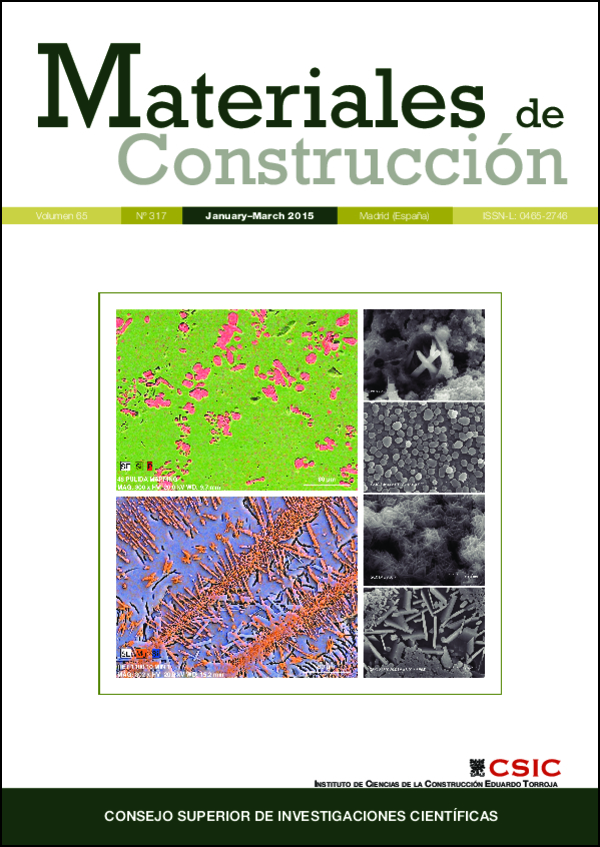Hidratación temprana y tardía de cementos supersulfatados de escoria de alto horno con fluoryeso
DOI:
https://doi.org/10.3989/mc.2015.06013Palabras clave:
Supersulfatado, C-S-H, Etringita, hidratación, microestructurasResumen
Se realizó la caracterización de la hidratación, desarrollo de resistencia y la composición de los productos de hidratación de los cementos supersulfatados durante las primeras 48 horas y hasta 360 días. Se estudiaron dos composiciones de 80% de Escoria de alto horno, 10–15% de Fluoryeso y 10–5% de Cemento portland, se curaron en condiciones secas y húmedas. Los principales productos de hidratación fueron etringita y C-S-H desde las primeras horas y hasta 360 días, como se evidenció por difracción de rayos X, análisis térmico y microscopía electrónica de barrido. La resistencia se favoreció con mayor contenido de fluoryeso y bajos contenidos de cemento portland. Estos cementos generaron calores de hidratación de 40–57 KJ/Kg después de 28 horas, los cuales resultan más bajos que los generados por el cemento portland.
Descargas
Citas
1. Escalante García, J.I. (2002) Alternative materials to Portland cement (in Spanish). Avance y perspectiva. 21, 79–88.
2. Gartner, E. (2004) Industrially interesting approaches to "low-CO2" cements. Cem Concr Res. 34, 1489–98. http://dx.doi.org/10.1016/j.cemconres.2004.01.021
3. Mehrotra, V.P.; Sai, A.S.R.; Kapur, P.C. (1982) Plaster of Paris Activated Supersulphated Slag Cement. Cem Concr Res. 12, 463–473. http://dx.doi.org/10.1016/0008-8846(82)90061-8
4. Taylor, H.F.W. (1997) Cement Chemistry, Academic Press, Inc New York.
5. Gruskovnjak, A.; Lothenbach, B.; Winnefeld, F.; Figi, R.; Ko, S.C.; Adler, M.; Mäder, U. (2008) Hydration mechanisms of super sulphated slag cement. Cem Concr Res. 38, 983–992. http://dx.doi.org/10.1016/j.cemconres.2008.03.004
6. Fernández Jiménez, A.; Puertas, F.; Fernández Carrasco, L. (1996) Alkaline-sulphate activation processes of a spanish blast furnace slag. Mater. Construcc. 46 [241], 23–37.
7. Ko, S.C. (2002) Alcali activated supersulphated blinder. United States Patent. Patent N°: US 6,409,819 B1.
8. Hewlett, P.C. (2004) Leaś Chemistry of Cement and Concrete, Elsevier Science & Technology Books Publishing.
9. Midgley, H.G.; Pettifer, K. (1971) The micro structure of hydrated super sulphated cement. Cem Concr Res. 1, 101–104. http://dx.doi.org/10.1016/0008-8846(71)90086-X
10. Bijen, J.; Niël, E. (1981) Supersulphated cement from blastfurnace slag and chemical gypsum available in the Netherlands and neighbouring countries. Cem Concr Res. 11, 307–322. http://dx.doi.org/10.1016/0008-8846(81)90104-6
11. Erden, E.; Ölmez, H. (1993) The mechanical properties of supersulphated cement containing phosphogypsum. Cem Concr Res. 23, 115–121. http://dx.doi.org/10.1016/0008-8846(93)90141-U
12. O´Rourke, B.; McNally, C.; Richardson, M.G. (2009) Development of calcium sulfate-ggbs-Portland cement binders. Constr and Build Mat. 23, 340–346. http://dx.doi.org/10.1016/j.conbuildmat.2007.11.016
13. Kondo, R.; Daimon, M.; Song, C.; Jinawath, S. (1980) Effect of lime on the hydration of super-sulfated slag cement. American Ceramic Society Bulletin. 59 [8], 848–851.
14. Norma ASTM C309-94. Standard practice for mechanical mixing of hydraulic cement pastes and mortars of plastic consistency.
15. Escalante García, J.I.; Sharp, J.H. (2000) The effect of temperature on the early hydration of Portland cement and blended cements. Adv Cement Res. 12 [3], 121–130. http://dx.doi.org/10.1680/adcr.2000.12.3.121
16. Magallanes Rivera, R.X.; Escalante García, J.I.; Gorokovsky, A. (2009) Hydration reactions and microstructural characteristics of hemihydrate with citric and malic acid. Constr Build Mat. 23, 1298–1305. http://dx.doi.org/10.1016/j.conbuildmat.2008.07.022
17. Shi, C.; Day, R.L. (1996) Some factors affecting early hydration of alkali-slag cements. Cem Concr Res. 26 [3], 439–447. http://dx.doi.org/10.1016/S0008-8846(96)85031-9
18. Matscei, T.; Lothenbach, B.; Glasser, P.F. (2007) Thermodynamics properties of Portland cement hydrates in the system CaO-Al2O3-SiO2-CaSO4-CaCO3-H20. Cem Concr Res. 37, 1379–1410. http://dx.doi.org/10.1016/j.cemconres.2007.06.002
19. Martínez Aguilar, O.A.; Castro Borges, P.; Escalante García, J.I. (2010) Hydraulic binders of fluorgypsum-portland and blast furnace slag, stability and mechanical properties. Constr Build Mat. 24, 631–639. http://dx.doi.org/10.1016/j.conbuildmat.2009.11.006
20. Escalante García, J.I.; F. Fuentes, A.; Gorokhovsky, A.; Fraire Luna, P.E.; Mendoza Suarez, G. (2003) Hydration products and reactivity of blast-furnace slag activated by various alkalis. J. Am. Ceram Soc. 86 [12], 2148–2153. http://dx.doi.org/10.1111/j.1151-2916.2003.tb03623.x
21. Matschei, T.; Bellmann, F.; Stark, J. (2000) Hydration behavior of sulphate-activated slag cements. Adv. Cem. Res. 18 [5], 167–178.
22. Odler, I. (2000) Special Inorganic Cements, E & FN Spon.
23. Gomez Zamorano, L.Y. (2004) Geothermal waste as a replacement material of portland cement pastes. PhD Thesis, Metallurgical and Ceramic Engineering. Cinvestav Unidad Saltillo, Mexico.
24. Escalante Garcia, J.I.; Sharp, J.H. (2004) The chemical composition and microstructure of hydration products in blended cements. Cem Concr Comp. 26, 967–976. http://dx.doi.org/10.1016/j.cemconcomp.2004.02.036
25. Shi, C.; Fernández Jiménez, A.; Palomo, A. (2011) New cements for the 21st century: The pursuit of an alternative to Portland cement. Cem Concr Res. 41, 750–763. http://dx.doi.org/10.1016/j.cemconres.2011.03.016
26. Escalante García, J.I.; Sharp J.H. (1999) Variation in the composition of C-S-H gel in Portland cement pastes cured at various temperatures. J. Am. Ceram. Soc. 82 [11], 3237–3241. http://dx.doi.org/10.1111/j.1151-2916.1999.tb02230.x
Publicado
Cómo citar
Número
Sección
Licencia
Derechos de autor 2015 Consejo Superior de Investigaciones Científicas (CSIC)

Esta obra está bajo una licencia internacional Creative Commons Atribución 4.0.
© CSIC. Los originales publicados en las ediciones impresa y electrónica de esta Revista son propiedad del Consejo Superior de Investigaciones Científicas, siendo necesario citar la procedencia en cualquier reproducción parcial o total.
Salvo indicación contraria, todos los contenidos de la edición electrónica se distribuyen bajo una licencia de uso y distribución “Creative Commons Reconocimiento 4.0 Internacional ” (CC BY 4.0). Consulte la versión informativa y el texto legal de la licencia. Esta circunstancia ha de hacerse constar expresamente de esta forma cuando sea necesario.
No se autoriza el depósito en repositorios, páginas web personales o similares de cualquier otra versión distinta a la publicada por el editor.
















